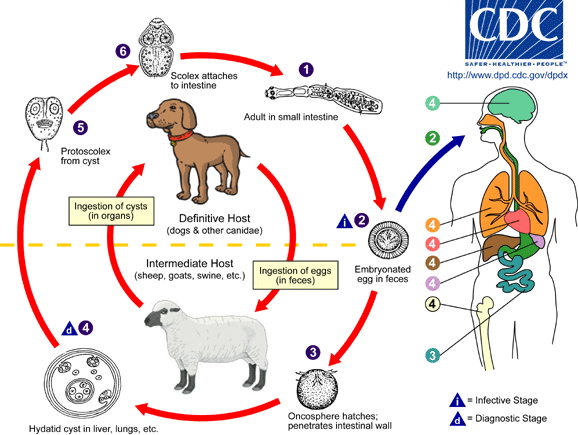Tapeworm–Echinococcus granulosus, the sheep tapeworm causes echinococcus or hydatidosis or Hydatid disease. This one is really bad as it gets into the brain of humans and grows. If the surgeon accidentally pops the sac containing the eggs, you can count on purchasing a cemetery plot.
Symptoms of Echinococcosis/Hydatidosis in the human include an enlarged liver, ascites, swollen abdomen and dull abdominal pain. A CBC (Complete Blood Count) may be high in eosinophils and there may be signs of hemolytic anemia (red cells bust up so there are not enough of them to assist the body in getting oxygen). Possible anaphylaxis can happen if the cysts are ruptured. Dogs don’t have any significant symptoms.
Diagnosis of Echinococcus granulosus: Often these are discovered only upon necropsy. Radiographs, ultrasounds, and serological testing of the blood can help rule in or out the diagnosis of Echinococcosis although if the cysts have never ruptured the tests could be falsely negative. You actually have to take an aspirate of the cyst to see the eggs in that fluid (this is called a Casoni test), but when you do this, you run the risk of spreading the parasite throughout the body.
Life Cycle and Stages of Echinococcus:
The cycle involves rodents or grass-eating animals (called ungulates) such as cattle, sheep, deer, elk and other animals with four stomachs. The ungulate eats the grass contaminated with infected dog poop that contains tapeworm segments full of eggs (gravid proglottids). The infective cyst matures into a metacestode and protoscoleces stage. Next, a dog comes by, eats the sheep liver or intestines and gets infected and the metacestodes and protoscoleces mature into the adult form which the dogs then poop out.
If humans eat or touch the uncooked meat and accidentally ingest the cysts, pre-adult stages or tapeworm segments (proglottids), they can take hold in our body and form cysts in our lungs, liver and inside our brain.
Prevention of Echinococcus: Worm your animals a couple times a year if they are out-of-doors and get into carcasses or catch game of any kind. This will help cut down on the spread of this disease. Echinococcus used to be common in meat packers (handling the infected liver’s of sheep and deer). The eggs, because they have a thick shell much like Taenia pisiformis, can survive for long periods of time outside the host.
How to diagnose Echinococcus: Worm your dog with a tapeworm medication (Droncit works) then paw through the feces and look for the small 3-segmented tapeworms. Washing the feces through a sieve also works to see the adult worms.
How to treat Echinococcus: There is not treatment for this disease but mebendazole and fenbendazole keeps the hydatid cyst from getting larger. The problem is the human has to be on these drugs for the rest of their lives.
Interesting Facts about Echinococcus: This disease has been eliminated in Iceland because there was a pamphlet put out describing how the life cycle works. Because Icelandic people are very educated and have lots of time to read for many months out of the year almost every knows about it. Amazing.
Echinococcus multilocularis: This tapeworm is similar to E. granulosus but it is transferred via Foxes, voles, and ground squirrels and is in the Northern states, Canada and Alaska. Gross pathology differs in that the cysts are filled with a cheese substance and it responds better to treatment (Mebendazole).
For more info on tapeworms in general go to: Tapeworm Introduction page.
Helpful Links and References:
Echinococcus Cysts in Livers of Sheep, cow, camel and yak: https://www.pubmedcentral.nih.gov/articlerender.fcgi?artid=145297&rendertype=figure&id=f3

